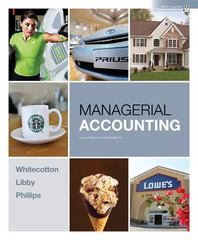Question
A few Questions.. 1. A manager hired an employee with more experience and skills than anticipated and at a higher rate than when the pay
A few Questions..
1. A manager hired an employee with more experience and skills than anticipated and at a higher rate than when the pay rate standards were set. This employees skills resulted in less labor hours than normal. What is the effect on the rate and efficiency variances respectively?
A. Favorable, favorable
B. Favorable, unfavorable
C. Unfavorable, favorable
D. Unfavorable, unfavorable
2 A manager purchased materials of inferior quantity for a lower cost than anticipated and the result was more spoilage than normal. What is the effect on the price and quantity variances respectively?
A. Favorable, favorable
B. Favorable, unfavorable
C. Unfavorable, favorable
D. Unfavorable, unfavorable
A company uses a single raw material in its production process. The standard price for a unit of material is $7.50. During the month the company purchased and used 9,500 units of this material at a price of $7.00 per unit. The standard quantity required per finished product is 4 units and during the month, the company produced 2,500 finished units. How much was the material price variance?
A. $3,750 favorable
B. $4,750 unfavorable
C. $4,750 favorable
D. $3,750 unfavorable
A company uses a single raw material in its production process. The standard price for a unit of material is $7.50. During the month the company purchased and used 9,500 units of this material at a price of $7.00 per unit. The standard quantity required per finished product is 4 units and during the month, the company produced 2,500 finished units. How much was the material quantity variance?
A. $4,750 favorable
B. $3,750 unfavorable
C. $3,750 favorable
D. $4,750 unfavorable
A company produced 2,700 units of output during a production process that normally requires 3 hours of labor per unit of output. The standard labor rate is $15 per hour, but the company paid $16 per hour. Actual hours needed to complete the production process were 7,700. How much was the labor efficiency variance?
A. $ 6,000 favorable
B. $11,400 favorable
C. $11,400 unfavorable
D. $ 6,000 unfavorable
A company produced 2,700 units of output during a production process that normally requires 3 hours of labor per unit of output. The standard labor rate is $15 per hour, but the company paid $16 per hour. Actual hours needed to complete the production process were 7,700. How much was the labor rate variance?
A. $11,400 favorable
B. $ 7,700 favorable
C. $11,400 unfavorable
D. $ 7,700 unfavorable
The overhead flexible budget variance indicates:
A. the difference between actual overhead and standard overhead.
B. how well management has controlled overhead costs.
C. the difference between the flexible budget and the standard budget.
D. how well management has met strategic goals.
The difference between the flexible budget overhead and the standard overhead allocated to
production is called the:
A. sales volume variance.
B. overhead flexible budget variance.
C. direct material variance.
D. production volume variance.
Step by Step Solution
There are 3 Steps involved in it
Step: 1

Get Instant Access to Expert-Tailored Solutions
See step-by-step solutions with expert insights and AI powered tools for academic success
Step: 2

Step: 3

Ace Your Homework with AI
Get the answers you need in no time with our AI-driven, step-by-step assistance
Get Started


